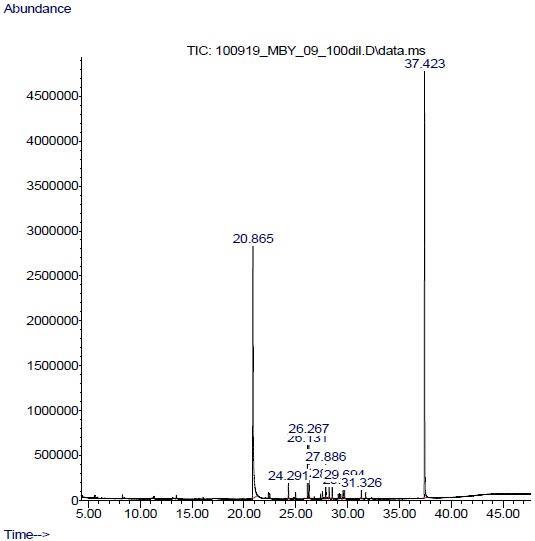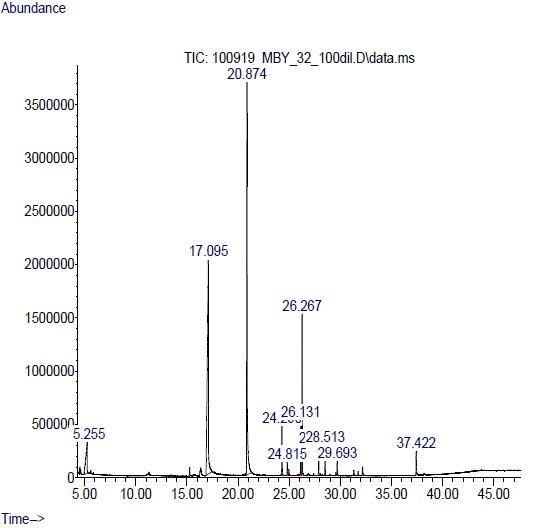ISSN 2348-313X (Print)
International Journal of Life Sciences Research ISSN 2348-3148 (online)
Vol. 8, Issue 1, pp: (1-4), Month: January - March 2020, Available at: www.researchpublish.com

ISSN 2348-313X (Print)
International Journal of Life Sciences Research ISSN 2348-3148 (online)
Vol. 8, Issue 1, pp: (1-4), Month: January - March 2020, Available at: www.researchpublish.com
1 , Ramalingappa B2
1, 2 Department of Microbiology, Davangere University, Davangere-577007, Karnataka, India.
*Corresponding author. E-mail: ramalingappa.88@gmail.com
Abstract: Microbial lipids are in the form of triacylglycerols (TAGs). Glucose was used as carbon source for accumulation of triacylglycerols. In this study, isolated fungi were screened for their lipid producing capacities by Sudan Black B staining method. Biochemical and molecular characterizations were done for identifications of potential lipid producers. The fungus Epicaleosporium ramularioids and Podosphaera xanthii showed its lipid productivity 24.2736% and 45.67% respectively. The extracted lipids were analyzed by Gas chromatography with mass spectroscopy for fatty acid determination.
Keywords: Lipids, Oleaginous, Sudan Black B stain, GC-MS.
Microorganisms can accumulate lipids more than 20% of their dry weight is called oleaginous. The obtained lipids are considered as raw material for production of biodiesel (Ratledge and Wynn, 2002). Subsequently, the production of biofuels like bioethanol and biodiesel has expanded worldwide for more than 10 years. Biodiesel, which is gotten from vegetable and animal fats, is for the most part a blend of unsaturated fat methyl esters (FAMEs). Utilization of biodiesel has been expanding quickly as an alternative source of energy (Meng et al , 2009). Nowadays, the exploration of oil producing microorganisms primarily center around the improvement of fermentative states of the current strain (Li et al., 2007) as well as screening functional oil producing microorganisms (Patnayak and sree, 2005). However, very few studies had been directly on isolating microorganisms from natural environment, which convert substrate to biodiesel. 20 strains isolated from oil rich soil and nut samples, which belong to 13 different species of fat yeast. This indicates there is abundant oil producing microorganisms in nature environment (Pan et al., 2009). Therefore, fat producing microorganisms are screening from natural environment, on one hand, it will expand the resources of oil microorganism sp., on the other hand, it also possibly obtains oil microorganism that have many industrial applications.
The soil samples were obtained for the isolation of microorganisms. Upon collection of soil samples were allowed to refrigerator condition at 4о C for further use. For isolation 0.1 ml of diluted soil suspension spread on yeast peptone dextrose agar medium (YPD) having the pH 5.5 and 6.5, the inoculated plates were kept for incubation at lab temperature for 3 days.
The oleaginous fungus was stained with qualitative analysis of Sudan Black B staining method and observes under a microscope for presence of intracellular lipids (Thakur, 1989).
ISSN 2348-313X (Print)
International Journal of Life Sciences Research ISSN 2348-3148 (online) Vol. 8, Issue 1, pp: (1-4), Month: January - March 2020, Available at: www.researchpublish.com
Some biochemical tests, such as Carbohydrate utilization test, Growth at different temperature (37оC and 4оC), Tolerance of 1 % acetic acid, Formation of extracellular amyloid compounds, Hydrolysis of urea, Growth in media of high osmatic condition, Gelatin liquefaction, and Production of lipase, were done for characterization of fungal isolates (Kurtzmann et al., 2011).
Lipid extracted by Bligh and Dyer method and selected potential strains were identified by 18S rRNA sequencing. The sequence alignments performed by MEGA blast with NCBI database (Bligh and Dyer, 1959; Edwards et al., 1989; Edgar, 2004).
The selected fungi exhibited maximum lipid accumulation Gas chromatography-Mass spectrometry (GC: Agilent 7890A MS: 5975C MSD) fitted with DB 5 MS column (Dimensions: 30m L x 0.25mm ID x 0.25um film thickness) was used to determination of fatty acid composition in lipids, and 2, 6 dihydroxyacetophenone used as a standard for quantification.
More than hundred isolates obtained from soil samples and they were screened by Sudan Black B staining for determine their capacity of intracellular lipids. Among all isolates only twelve were identified as oleaginous or potential lipid producers, out of twelve isolates only two fungi were selected for further studies as indicated in the name of MBY-32 and MBY-09.
Biochemical characterization of fungi as shown in Table.1
Tests
MBY-32 at pH 5.5 (Epicaleosporium ramularioids)
MBY-09 at pH 6.5 (Podosphaera xanthii)
Fermentation of carbohydrates +ve +ve
Growth at 37o C +ve +ve
Growth at 4o C -ve -ve
Tolerance of 1% acetic acid -ve -ve
Formation of extra cellular amyloid compounds +ve +ve
Hydrolysis of urea -ve +ve
Growth in media of high osmotic condition +ve -ve
Gelatin liquefaction +ve +ve
Lipase activity +ve +ve
Extraction of lipids from fungus (MBY-32) showed its lipid productivity 24.2736%, and another fungus (MBY-09) showed its lipid productivity 45.67%. These two oleaginous fungi were characterized 18S rRNA typing and identified as Epicaleosporium ramularioids and Podosphaera xanthii
The various compounds present in lipids, extracted from Epicaleosporium ramularioids and Podosphaera xanthii have shown in following graph.
ISSN 2348-313X (Print)
International Journal of Life Sciences Research ISSN 2348-3148 (online) Vol. 8, Issue 1, pp: (1-4), Month: January - March 2020, Available at: www.researchpublish.com
The fatty acids profiles of lipids showed saturated fatty acids, such as Tridecanoic acid, 12-methyl-,methyl ester (2.527%), Pentadecanoic acid, methyl ester (2.899%), Methyl 13-methyltetradecanoate (8.425%), Pentadecanoic acid, 14methyl-,methyl ester (1.515%), Hexadecanoic acid, methyl ester (1.545%), Methyl 15- methylhexadecanoate (0.762%) Other compounds such as isocrotonic acid (7.447%), Ethyl cyclopropanecarboxylate (39.685%), 2’, 6’Dihydroxyacetophenone (32.828%) and Oxazolidin-2-one, N-[(E)-butenoyl]-(0.788%), compounds were present in total amount of lipids.
Another above graph indicates the fatty acids profiles of lipids showed saturated fatty acids, such as Tridecanoic acid, 12methyl-, methyl ester (1.331%), Pentadecanoic acid, methyl ester (4.593%), Tetradecanoic acid, 12-methyl-, methyl ester


ISSN 2348-313X (Print)
International Journal of Life Sciences Research ISSN 2348-3148 (online) Vol. 8, Issue 1, pp: (1-4), Month: January - March 2020, Available at: www.researchpublish.com
(5.583%), Pentadecanoic acid, 14-methyl-, methyl ester (2.907%), Hexadecanoic acid, methyl ester (1.620%), Heptadecanoic acid, methyl ester (0.964%), Hexadecanoic acid, 14-methyl-, methyl ester (1.486%), and monounsaturated fatty acids, such as 9-Hexadecenoic acid, methyl ester, (Z)- (1.638%) and 9-Octadecenoic acid, methyl ester, (E)(0.859%) and other compounds 2',6’Dihydroxyacetophenone (37.743%) and 1,2-Benzenedicarboxylic acid, diisooctyl ester (37.421%) were present in total amount of lipids.
Carbon source is playing an important role in accumulation of intracellular lipids in microorganisms. In this study, isolation of fungi from soils was collected from different gardens, and screening of lipid production by Sudan Black B staining method. Various biochemical parameters were considered to differentiate fungal isolates, these tests included several physiological aspects of fungi. The fungi Epicaleosporium ramularioids showed its lipid productivity is 24.2736%, which has isolated at pH 5.5 and another fungus Podosphaera xanthii showed its lipid productivity 45.67%, which has isolated at pH 6.5. The other oleaginous fungi Galactomyces geotrichum showed its dry biomass 2.6 g/L, Lipid yield 0.352 g/L and Lipid productivity 17% (Neema and Kumari, 2013) These extracted lipids were analyzed by GC-MS that showed numerous saturated and monounsaturated fatty acids, which were identified as qualitatively and quantitatively.
[1] Thakur MS, Prapulla SG, Karanth N. (1988). Microscopic Observation of Sudan Black B Staining to monitor Lipid production by Microbes, Journal of Chemical Technol and Biotechnol. 42 (2): 129-134.
[2] Bligh EG, Dyer WJ (1959). A rapid method of total lipid extraction and purification, Canadian Journal of Biochem and Physiology. 37: 911-917.
[3] Edwards U, Rogall T, Blocker H, Emde M, Bottger EC. (1989). Isolation and direct complete nucleotide determination of entire genes: characterization of gene coding for 16S ribosomal RNA, Nucleic Acids. 17 (19): 7843-7853.
[4] Edgar RC. (2004). Muscle: multiple sequence alignment with high accuracy and high throughput. Nucleic Acids Res. 32 (5): 1792-1797.
[5] Kurtzman CP, Fell JW, Boekhout T, Robert V. (2011). The Yeast, a taxonomy study. Elsevier, Amsterdam.
[6] Meng X, Yang JM, Xu X, Zhang L, Nie QJ, Xian M. (2009). Biodiesel production from oleaginous microorganisms, Renew. Energy. 34 (1): 1-5.
[7] Neema PM, Kumari A. (2013). Isolation of lipid producing fungi from secondary sewage sludge and soil, Australian Journal of Basic and Applied Sciences. 7(9): 283-288, 2013.
[8] Pan LX, Yang DF, Shao L, Li W, Chen GG, Liang ZQ. (2009). Isolation of oleaginous yeast from the soil and studies of their lipid producing capacities, Food Tech and Biotech 47(2):215-220.
[9] Patnayak S, Sree A. (2005). Screening of bacterial associates of marine sponges for single cell oil and PUFA, Lett Appl. Microbio. 40:358-363.
[10] Ratledge C, Wynn James P. Advances in Applied Microbiology. (2002). The Biochemistry and Molecular Biology of Lipid Accumulation in Oleaginous Microorganisms; 1–52.
[11] Li Y, Zhao Z, Bai F. (2007). High-density cultivation of oleaginous yeast Rhodosporidium toruloides Y4 in fed batch culture, Enzyme Microb. Technol. 41 (3): 312–317.